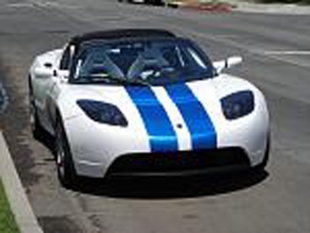 I really appreciated all the positive feedback on my Tesla post a few weeks ago. I also appreciated the many questions and wanted to address some of them. In particular, Dennis asked some specific questions about the efficiency of the electric car versus a conventional gasoline car.
I really appreciated all the positive feedback on my Tesla post a few weeks ago. I also appreciated the many questions and wanted to address some of them. In particular, Dennis asked some specific questions about the efficiency of the electric car versus a conventional gasoline car.
In order to compare efficiency on an apples-to-apples basis, you want to compare what’s called “well-to-wheels” efficiency. The “well” in this case is the original energy source; the “wheels” are those round things on the car. For a conventional car the “well” is an actual oil well (hence the name), where crude is produced that is eventually refined into gasoline. For an electric car, the “well” is the energy source used to produce the electricity, which in California could be anything from coal to natural gas to hydropower to geothermal sources. The term “well-to-wheels” thus refers to the completeness of energy conversion, or, if you prefer, the energy losses along the way, from the energy source to the end result that your car moves you around.
There is not as much information out there on this comparison as you might think. I found myself purchasing a couple of scientific journal papers, musing over Wikipedia articles, and at one point even staring at a whole report in German. (I used to be pretty good at German, but that was long ago.) An Italian study concluded that battery electric vehicles would have a well-to-wheels energy efficiency of over 60% if they could run on power produced from renewable sources, but only about 25% to 30% if they ran on power from coal, natural gas, or the typical Italian energy grid mix. For comparison, a web article published by the International Association for Natural Gas Vehicles posits that a conventional gasoline vehicle is only 12% efficient on a well-to-wheels basis, though I have not found a lot of independent verification for this figure.
I compared the Italian energy grid mix (as indicated by the non-profit Global Energy Network Institute) to Southern California Edison’s sources and with one notable exception, it’s quite similar: about half from natural gas, perhaps 15% from coal (10% for Edison), and the rest from a combination of large- and small-scale hydroelectric and renewables like geothermal and wind. The big difference is that 18 percent of Edison’s power comes from nuclear; that gap is made up in Italy by oil. This means that a battery car here would generate somewhat lower CO2 and other pollutant emissions than the cars being examined in Italy. (For those in the territory served by the Los Angeles Department of Water and Power, a different mix prevails, notably involving 44% of power from coal.) The German study I mentioned above, according to this cnet blog post, likewise found that aggressive deployment of electric cars would reduce CO2 emissions very little unless peak power needs were met by renewables rather than coal.
Dennis asks whether using a battery car doesn’t just relocate the pollution source from the car to the power plant. It certainly does: and the power plant emissions are much easier to control than the emissions from millions of tailpipes. Moreover, power plants, even of the oldest and simplest variety, are no less efficient than internal combustion engines, and newer plants are better, with “combined cycle” plants, where waste heat is captured and used to generate additional energy, achieving up to 60% efficiency. This means the emissions are likely to be lower at the power plant than at the vehicle for the same amount of power production. Another reason for this difference is that natural gas – the source of about half our electricity – burns cleaner and produces fewer emissions than gasoline for the same amount of energy. However, based on the information I’ve found so far, I can’t calculate a ratio of the emissions from a conventional engine to those associated with a comparable electric drive train. Also, as Dennis points out, there are losses in the transmission of power, but they amount to only about 7 percent of the energy, according to the U.S. Climate Technology Program.
The Italian study concludes that CO2 emissions, on a well-to-wheels basis, are lower for battery cars fueled by renewables than for conventional engines. But it identifies some commercially available cars that are at least as clean and efficient as battery electric cars powered by a mix of energy sources. The Audi Q7 TDI (a diesel SUV) performs just the same, and vehicles including a Toyota Yaris diesel and of course the hybrid Toyota Prius and Honda Insight have lower emissions. The Hummer H2 and a performance Ferrari have much higher CO2 emissions; I’m not sure about Dennis’s Honda Pilot.
As to the more efficient conversion of fuel or power to movement, if you will believe figures compiled by Tesla here, a gasoline Honda Civic VX (one of the most fuel-efficient conventional cars ever made) can go 0.63 kilometers (about four-tenths of a mile) using an amount of energy called a megajoule. Using that same megajoule, the Tesla Roadster can travel 2.18 kilometers – about a mile and a third. So the car itself – “tank-to-wheels” – is clearly more energy-efficient. The Tesla chart presents a well-to-wheels comparison of several vehicle types.
While the comparison’s not as clear-cut or obvious as I expected, after reviewing this information I’m reassured that our electric car is certainly not contributing any more to our carbon footprint than, say, our previous cars, and it’s probably contributing less. It undeniably emits less pollution in Long Beach.
The other questions will have to wait for another post.

